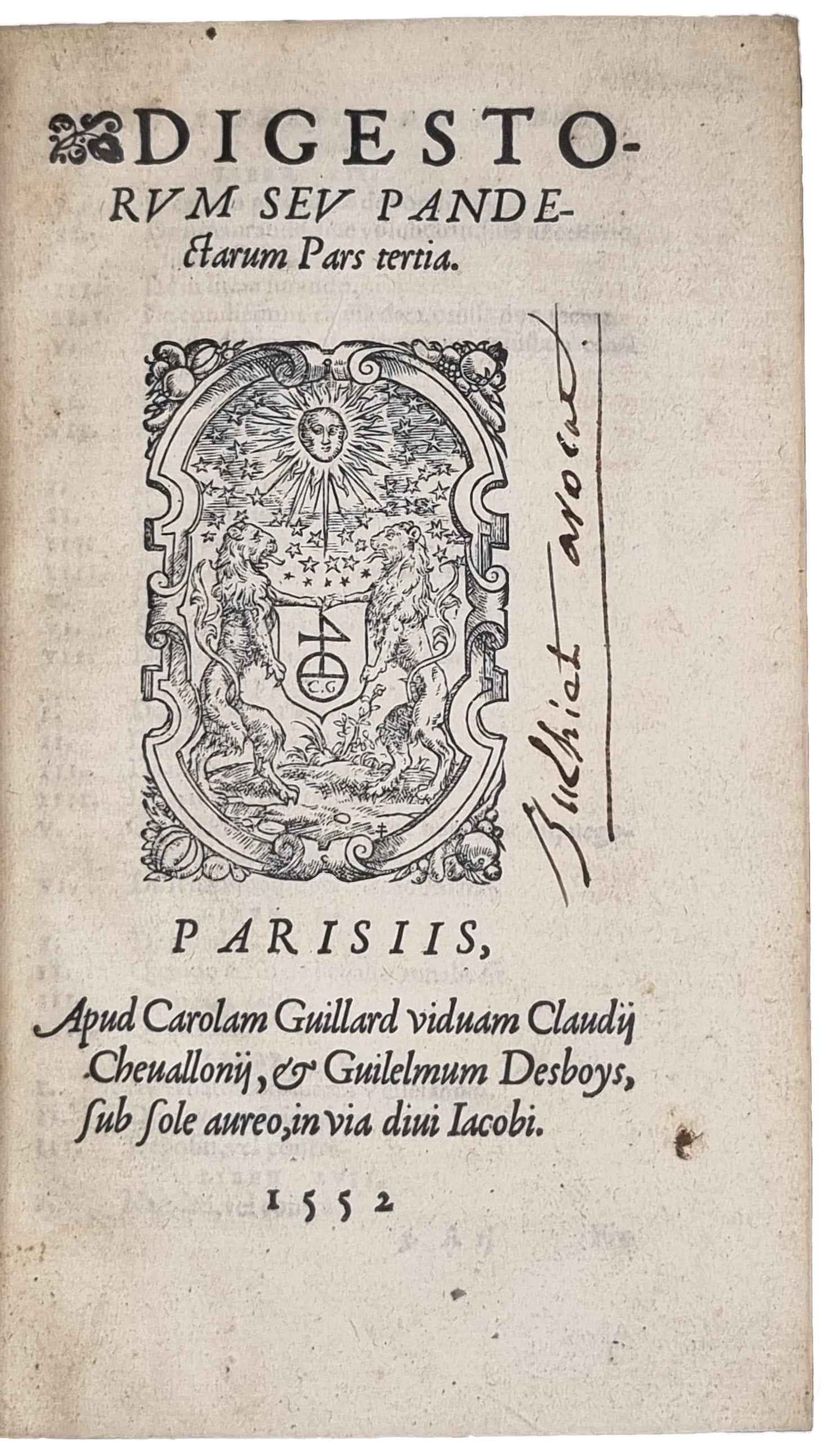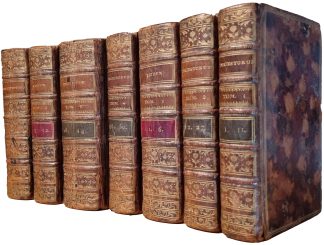JUSTINIAN.
BY A MAJOR FEMALE PRINTER
Codex. Digestus. Institutiones.
Paris, Charlotte Guillard & Guillaume Desboys, 1552-53.£5,850.00
8vo. 3 works in 8 parts in 7 vols, Codex: I: ff. [40], 491, [1]; II: 367, [1], [52]; Digest: I: ff. [58], 312, [1]; II: ff. [2], 313-721, [1]; III: ff. [2], 725-1078, [6], 1079-1411, [1]; IV: ff. [2], 1408-1689, [116, index]; Institutes: I: ff. 367, [1]. Roman letter, occasional Greek or Italic. Woodcut printer’s device to 4 titles of Digest, decorated initials and ornaments. Light age yellowing, minor worming to lower blank margin of final gatherings of Digest, vol.4, and outer margin of first three gatherings of Institutes, occasional minimal marginal spotting. A crisp and clean set in uniform French marbled cat’s paw calf c1700, marbled eps, triple gilt ruled, raised bands, spines gilt and gilt-lettered, morocco labels, outer edges gilt, a.e.g. and marbled, silk bookmarks, wear to corners and head and foot of spine in places, upper joint of Digest, vol.4, just split at head, C18 ms ‘Julihet Avocat’ to most titles.
Charlotte Guillard (b.1480s), widow of Berthold Rembolt, active in Paris in the first quarter of the C16, the first major female printer of France. Her husband had been an associate of Ulrich Gering, owner of the most prestigious Parisian press, Le Soleil d’Or. ‘In C16 Paris, businesses and crafts were still regulated by the guild system, which allowed women to take over the direction of the businesses after the deaths of their husbands, even in those businesses which were normally closed to women. One result of this was that many Parisian women led active and varied economic lives. A little noticed aspect is that some women became book publishers and printers. These women publishers and printers had to possess both scholarly training and managerial and business skills, in order to compete and survive in the publishing world’ (Beech, p.346). The present works were printed after the death of her second husband, Claude Chevallon, in 1537, when her name reappeared in imprints. Until her death in 1557, she printed or published approximately 158 different titles, especially works for the student market, popular readers and religious institutions.
A fine, uniformly bound set of the complete ‘Corpus iuris civilis’ patronised by Emperor Justinian – a fundamental reference instrument of Roman law for early modern lawyers, and a milestone of feudal and imperial law. Sets are rarely found uniform and complete, as purchasers selected or mixed parts and editions. Justinian I (482-565) ruled for forty years over the Byzantine empire succeeding in temporarily rekindling the former splendour of Rome. He is best known for the ‘Corpus iuris civilis’—comprising the ‘Codex Justinianum’, the ‘Digesta’ or ‘Pandectae’, the ‘Institutiones’ and the ‘Novellae Constitutiones’, all present here—a compendium of all the decrees passed by the Roman emperors, which became the official reference work on civil law from 529. Edited by Ludovicus Miraeus, these texts are based on those of Gregorius Haloander (1501-31), professor at Nuremberg, who had examined early Greek ms versions. The ‘Codex’ was a compilation of all imperial laws that existed in the 6th century; this second version – the definitive and only extant, issued not long after the first – incorporated also 50 ‘decisions’ issued to solve conflicting interpretations derived from previous Roman codes. Its fourth part, ‘Novellae’, was published after Justinian’s death to include recently passed decrees. It covers a wide array of subjects in great depth, from laws of inheritance to mortgaging ecclesiastical property, incest, and the oaths of public officials. It also shows how Roman laws were applied in colonial territories, e.g., in matters relating to the Church and the inheritance of family estates in Africa. In addition to providing a final codification of Roman law, Justinian also intended to reform legal education. ‘Institutiones’ was intended as a law textbook for students, preparatory to the ‘Digest’, as a selection of extracts from the ‘Codex iuris civilis’, dealing with ‘persons’, ‘things’ and ‘actions’. Important sources are the Roman jurists Gaius, Ulpian, Marcian and Florentinus. The ‘Digest’, or ‘Pandectae’, was a compendium for advanced law students, mostly based on Ulpian. It became the sole authorized source of non-statutory law, including topics as unexpected as marine insurance. Written commentaries and interpretations were forbidden under Justinian.
This copy was in the library of the French lawyer Julhiet, probably a C18 member of the influential family from Valence. The most likely candidate – François-Bonaventure Julhiet (1760-1835) – was royal notary and mayor of Peyrins.
Brunet III, 607 (‘rare’, mentioned). Jimenes 153, 157, 151, 152; USTC 151015, 151240, 196553, 151169; Adams J-511, 573, 574, 575, 679. Only Harvard copies recorded in the US. B. Beech, ‘Charlotte Guillard: A Sixteenth-Century Business Woman’, Renaissance Quarterly, 36 (1983), 345-67; R. Jimenes, Bibliographie de Charlotte Guillard (2017).In stock







